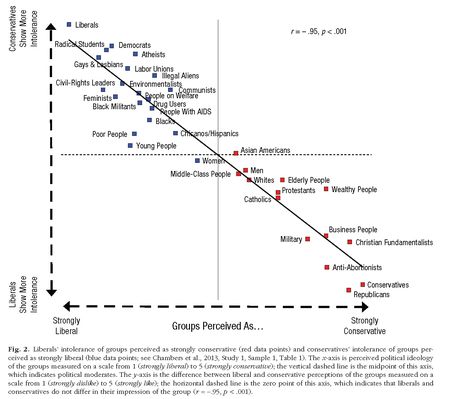By Dr. Ken Broda Bahm:
It’s Valentine’s time again. It’s a holiday of love, but in the political world, we’re moving out of yet another debt ceiling standoff and there is no love lost between the two sides of the spectrum. Liberals point to yet another, albeit failed, attempt to hold the country’s full faith and credit hostage, while conservatives point to yet another increase in an already staggering national debt. Neither side can understand the values, arguments, and priorities of the other. And that’s just the debt. Add in social welfare programs, marriage equality, and — as the actual sign from an Arizona gun shop above testifies — gun control, and you’ve got a pretty bitter divide. Polling shows that we are politically more ‘tribal’ than ever before. As we’ve noted in earlier posts, liberals and conservatives appear to use their brains differently when assessing risk, and are resistant to applying basic empathy across the political aisles.
One additional example of this equal understanding not being extended to the other side might be found in the research itself. For decades, it has been a common social science finding that political conservatives are less tolerant of other groups than liberals are. However, a current study (Brandt et al., 2014) involving three different laboratories and a number of different populations and research approachs has called those conclusions into question. Noting that this finding of “conservative intolerance” appears to be an artifact of social scientists’ focus on attitudes toward liberal groups, the research shows that “both liberals and conservatives express intolerance toward groups with whom they disagree,” seeing those groups as ideologically different and therefore threatening to their own worldviews. This has implications for persuaders who are often asking audiences to identify with someone who is “other.” In this post, I’ll be taking a look at the new study and what it says about intolerance based on ideology as well as a number of associated demographics, before ending with a few reminders for persuading in an intolerant world.
The Research: Intolerance Cuts Both Ways
These days, those on different sides of the political divide don’t simply hold different beliefs, they start with different facts, hold radically different views of what’s most important, subscribe to different values, and get their news from different sources. It would make sense that intolerance would apply in both directions. Still, the recent article (Brandt et al., 2014) points to a generation of studies generally showing that those with right-leaning political beliefs are more prejudiced toward others, more politically intolerant, and more willing to deny rights to less favored groups. Referring to this as the “prejudice gap,” the researchers set out to study the other side of the equation. They worked in three independent labs, using student samples, community samples and a representative U.S. sample spanning three decades. They also used several different measures of tolerance (e.g., like-dislike scales, ‘feeling thermometers,’ willingness to discriminate, etc.) and focused on a number of different groups seen as liberal, conservative, or somewhere in between.
They concluded: “Our studies showed that people across the political spectrum think their positions on issues of the day are correct, denigrate people who disagree with them, and express revulsion toward people who violate their moral values.” What about the previous finding that conservative groups are less tolerant? That, according to the researchers, may be a result of the fact that liberal groups were disproportionately studied as targets for intolerance. “If researchers had spent the last six decades studying intolerance toward conservative instead of liberal groups,” they explain, “the field would have a much different view of the tolerant liberal.”
The Specifics: Who Is Intolerant of Whom?
Beyond finding that intolerance is not simply a conservative affliction, the most interesting part of the article is the following table showing which groups are stereotyped and disparaged by each end of the political spectrum:
(Table used under license from Sage Publications. Click on graph to see to see full-sized image).
If conservatives think liberals are intolerant, and liberals think conservatives are intolerant, it turns out that both are right! The researchers demonstrated that conservatives’ tendency to show intolerance toward the dots in blue is roughly matched by liberals’ tendency to show intolerance toward the dots in red. Wherever you are on the political spectrum, there is likely someone perceived to be on the other side who is accorded a bit less understanding, respect, and tolerance.
The Recommendations: Acknowledge, Assess, and Adapt
So a certain level of intolerance for those on the other side of the ideological divide is a background condition for human influence. So how do persuaders adapt? Let me suggest “Three A’s.”
Acknowledge
Acknowledge that you have an ideological bias. But as a persuader, try your best to check that bias at the door.
Be careful of your own presumptions. If you think conservates are closed-minded and heartless, then you may be a liberal. If you think that liberals are emotional and irrational, you may be a conservative. Those perceptions are barriers to seeing the individuals you are trying to persuade. Advocates, including those in court, need to acknowledge their perceptions, but draw a distinction between group stereotypes and indvidual knowledge and try to cultivate an open-mindedness. As the study authors note, “We hope that this work gives ideological rivals pause to first consider their own biases, prejudices, and expressions of intolerance before dismissing alternative points of view.”
Assess
Ask whether you, your parties, your witnesses are likely to be seen as out-group members.
Take another look at the table above: Where would your parties and witnesses fit in? Where would most of the jurors in your venue fit in? The credibility that is accorded and the comprehension of motives that jurors will give will depend, to some extent, on perceived similarity. That similarity isn’t simply demographic, but also attitudinal. Jurors reviewing someone perceived to be in an out-group will have a challenge being fair. And it may be necessary to broaden our concept of what counts as an “out-group.” The article mentions research showing that the concept can be based “on the most minimal of criteria,” citing a study in which participants were willing to discriminate even against members of groups that were randomly chosen.
Adapt
Tailor your message so it emphasizes points of similarity, not difference.
In the narrow and brief confines of legal persuasion, you are unlikely to change your fact finders’ worldview. So your best bet lies in finding a way to join your preferred outcome with their worldview. That means that if your jurors are likely to see your party or witness on the wrong end of the ideological spectrum, then it is up to you to find and emphasize similarities. Everyone is more than one factor. A young, urban, gay male might also have a middle-class, military, or religious background. A cornerstone of audience analysis is finding the points of similarity where even the outlier has a point of overlap with the audience. That can be an important consideration in introducing your parties and your witnesses to your fact finders.
The research finding that “intolerance knows no ideological bounds,” and the consequent need for conscious open-mindedness in persuaders, calls to mind a celebrated essay on “Arguers as Lovers” by the rhetorical scholar Wayne Brockreide (1972). Much more fitting for Valentine’s Day, the perspective here is that effective advocacy stems from a fundamental respect and care for the other side. Appreciate where they are coming from, even if you don’t agree, and always believe in their capacity for good judgment even as it procedes on different terms than your own.
______
Other Posts on Political Difference:
- Speak to the Brain’s Politics
- Address Fundamental Skepticism on Rule of Law
- Know the Limits of Political Empathy
______
Brandt, M. J., Reyna, C., Chambers, J. R., Crawford, J. T., & Wetherell, G. (2014). The Ideological-Conflict Hypothesis Intolerance Among Both Liberals and Conservatives Current Directions in Psychological Science, 23 (1), 27-34
Image Credit: Arizona gun store advertisement placed after the election in the White Mountain Independent newspaper

